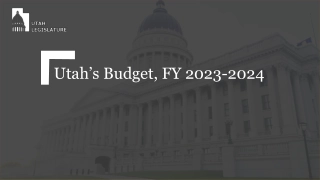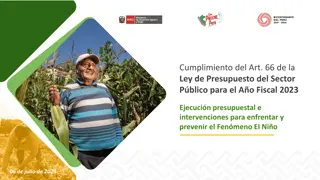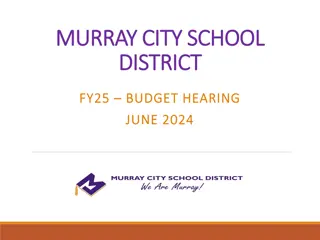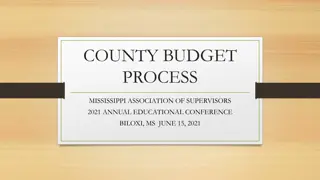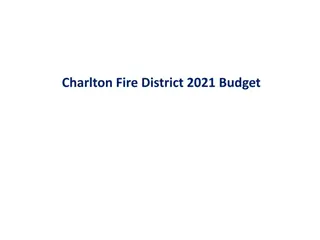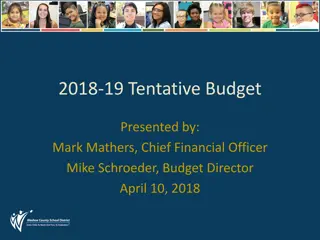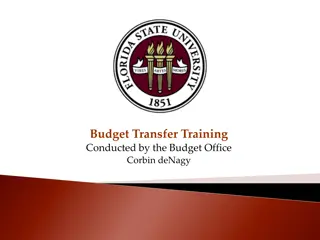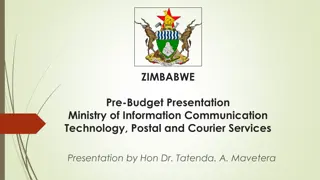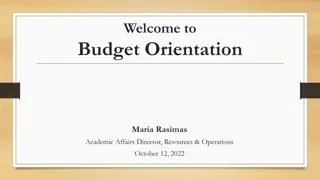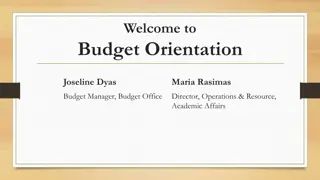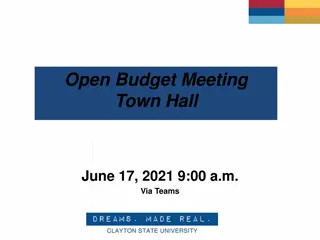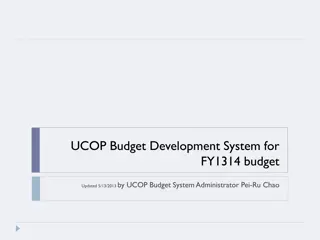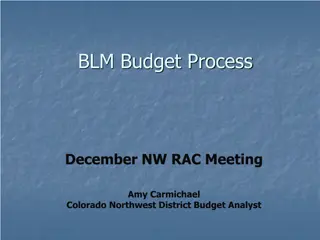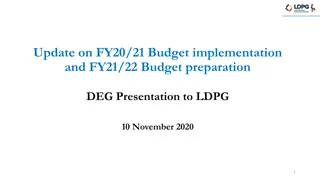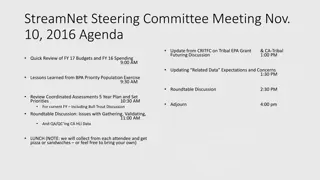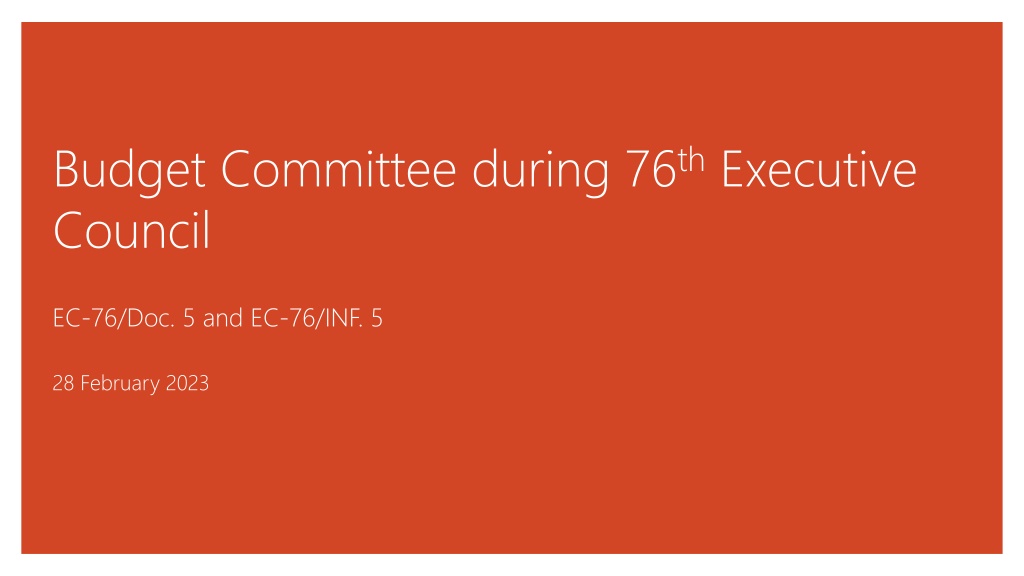
Budget Committee Goals and Financial Implications Summary
The Budget Committee during the 76th Executive Council aims to identify a consensus on maximum expenditure levels for 2024-2027, update recommendations to the Cg-19, and provide guidance on modifications. The financial implications and prioritization analyses are essential for decision-making, aligning with the Strategic and Operating Plans for the coming years. The proposals cover various areas like early warning systems, climate information, and Earth system observations. Key discussions include programmatic prioritization, travel costs, and short-term staffing. The goal is to optimize funding for societal needs and advance scientific knowledge while closing capacity gaps, especially in developing countries.
Download Presentation

Please find below an Image/Link to download the presentation.
The content on the website is provided AS IS for your information and personal use only. It may not be sold, licensed, or shared on other websites without obtaining consent from the author. Download presentation by click this link. If you encounter any issues during the download, it is possible that the publisher has removed the file from their server.
E N D
Presentation Transcript
Budget Committee during 76thExecutive Council EC-76/Doc. 5 and EC-76/INF. 5 28 February 2023
Goal of Budget Working Group Identify, from the EC-76 perspective, a consensus Maximum Expenditure level for 2024-2027 Propose updates to the Recommendation to Cg-19 on the level of Maximum Expenditures for 2024-2027 (EC-76/Doc. 5) Provide guidance to the Secretariat on modifications to the issued INF document in line with the above 2
FINAC Report and EC Comments SG s Proposal was considered by FINAC as not affordable Requested certain analyses (to be provided during Budget Committee/EC-76): Information by object of expenditure for the five major key deliverables funded in the SG s Proposal Financial Implications of programmatic prioritization made based upon the Operating Plan Evolution of travel costs with particular emphasis on WMO Secretariat travel and Evolution of short-term staff and consultant costs Adjust Operating Plan to identify (to be provided after EC-76): Milestones that could be delivered under ZNG scenario Discussion of what else could be delivered at the level of SG s Funding or other scenarios 3
Alignment with the Strategic and Operating Plan Strategic Plan 2024-2027 Operating Plan 2024-2027 Maximum Expenditures 4
Financial implications of programmatic prioritization Area of Increase from ZNG Scenario to SG Proposal Secretary- General's Proposal Other Enabling Activities ZNG Scenario EWS4A GHG RO Reform Hydrology AP Cryosphere LTG / Strategic Objectives Programmatic Part I. LTG 1. Better serve societal needs SO 1.1 Multi-hazard early warning systems SO 1.2 Climate information and services SO 1.3 Water management SO 1.4 Weather information and services SO 1.5 Cryosphere and Downstream Impacts 16,527.3 17,296.7 10,837.8 9,712.0 1,689.5 - - - - - - 158.3 - - - - - - 39.9 84.6 33.7 438.2 68.0 251.0 18,853.2 17,449.2 12,336.8 9,712.0 1,244.9 59,596.1 - - - - - - - - 1,214.3 - - - - - 981.6 981.6 28.7 187.0 234.6 991.7 Sub-total 54,373.8 1,689.5 158.3 1,214.3 Part II. LTG 2. Enhance Earth system observations and predictions SO 2.1 Acquisition of observation data SO 2.2 Access to Exchange and management of data SO 2.3 Numerical analysis and prediction 30,070.5 11,365.4 7,589.7 49,025.6 1,105.8 140.0 140.0 1,385.8 481.4 331.4 941.4 1,754.2 290.1 - - - - - - - - 841.5 10.1 22.8 874.4 670.9 104.0 234.1 1,009.0 33,460.2 11,950.8 8,928.0 54,339.0 - - Sub-total 290.1 Part III. LTG 3. Advance targeted research SO 3.1 Advance scientific knowledge of the Earth system SO 3.2 Improve predictive capabilities SO 3.3 Advance policy-relevant science 9,790.9 8,739.0 7,166.1 25,696.0 6.0 14.0 32.0 52.0 348.6 348.6 90.8 - - - - - - - - 382.4 265.3 41.9 689.6 194.1 147.2 17.3 358.6 10,812.8 9,514.0 7,257.3 27,584.1 - - - Sub-total 697.2 90.8 Part IV. LTG 4. Close the capacity gap SO 4.1 Address the needs of developing countries SO 4.2 Develop and sustain core competencies and expertise SO 4.3 Scale-up effective partnerships for investment 38,955.5 16,289.9 5,768.8 61,014.1 69.6 56.0 6.0 131.6 - - - - 2,449.4 - - - - - - - - 795.5 422.9 113.7 1,332.2 777.0 113.8 145.0 1,035.8 43,046.9 16,889.2 6,532.2 66,468.3 6.6 498.8 2,954.7 Sub-total Part V. LTG 5 Strategic realignment of WMO structure and programmes SO 5.1 Optimize WMO constituent body SO 5.2 Streamline WMO programmes SO 5.3 Advance equal and effective participation of women and men SO 5.4 Environmental sustainability 1,034.2 3,626.2 88.6 - - - - - - - - - - - - - - - - - - - - - - - - - - - 1,034.2 3,675.6 138.0 148.1 4,995.9 40.0 40.0 120.0 200.0 9.4 9.4 28.1 46.9 - Sub-total, Long-Term Goals 4,749.0 5 SUB-TOTAL 194,858.5 3,258.8 2,451.3 3,493.9 1,214.3 981.6 3,283.1 3,442.0 212,983.5
Financial implications of programmatic prioritization Area of Increase from ZNG Scenario to SG Proposal Secretary- General's Proposal Other Enabling Activities ZNG Scenario EWS4A GHG RO Reform Hydrology AP Cryosphere LTG / Strategic Objectives Programmatic Part VI. Policy-Making Organs & Executive Management Policy -Making Organs (Cg, EC, Bureau and FINAC) Executive Management External and Internal Oversight 5,499.1 32,591.8 4,928.9 - - - - - - - - - - - - - - - 272.1 317.0 63.7 74.3 5,834.9 32,983.2 4,928.9 - - SUB-TOTAL 43,019.9 - - - - - 589.1 138.0 43,747.0 PART VII. Language Services 33,666.0 - - - - - - - 33,666.0 TOTAL 271,544.4 3,258.8 2,451.3 3,493.9 1,214.3 981.6 3,872.2 3,580.0 290,396.4 6
Early Warning Services - Delivered under ZNG MHEWS guidance and Cataloging of Severe weather, water and climate in English Material developed for EWS available in English as base line Guides, Online IBF resources, CAP helpdesk Expansion of WMO supportive frameworks with additional RSMCs or functionality: Multiple centers established with conservative hazard list Modest expansion of the list of additional hazards supported by RSMCs, (e.g. heatwaves) LDCs and SIDS are supported Secretariat coordination and support prioritized GBON implementation (supported by SOFF in LDCs and SIDS) 8
Early Warning Services - Additional under SGs Proposal Regional needs better covered by RSMCs Support to development of new centre designations and functions Tailored development with subregional approaches and additional hazards, Heatwave warnings established globally Training material for IBF, CAP etc made available in multiple languages Increase capability of National users of warning information for optimizing usage of CAP messages across all media and down to community level Improved access and capacity development for use of satellite data to support nowcasting in areas with limited in situ observations Development of frameworks to support members in better use of products from global NWP centres and More countries beyond LDCs and SIDSs are supported Advance science and develop innovative methods to improve forecasts and predictions at local/regional scale Additional Secretariat coordination with partners and support to address upscaling and support to constituent bodies 9
Plan of Action for Hydrology Within ZNG, funding for activities has been requested; however, the ZNG scenario does not include the funding for the 1 staff positions required to implement the activities within the Financial Period. As Hydrological Action Plan approved by Cg-2021 would not be able to be implemented within the Financial Period. Delivered under ZNG Implementation of HydroSOS in limited countries prioritization required (note it is a priority for RA and countries) Fewer best practices investigated for implementation Additional under SG s Proposal Global State of Water Resources Reports HydroSOS implemented Hydrological Action plan implementation as approved by Cg-2021 with required Secretariat support Establishment of new WIPPS Centers on Hydrology Increased outreach on added value of NHSs to support decision making CoP established on hydrological issues (flood forecasting, water resources assessment etc.) Capacity development through twinning and e-learning 10
Cryosphere and downstream impacts Delivered under ZNG Integration of Cryosphere activities in INFCOM and continued support to AG-Cryo SO 1.5 cannot be implemented, cryosphere services not adequately reflected in WMO workplan P&HM hazards partially included in EW4All Limited, but insufficient progress on RCC in polar regions and approved WIPPS Centers on snow cover prediction Additional under SG s Proposal Full implementation of SO1.5 as per 2024-2027 Strategy with Secretariat's support Support to 2025 International Year on Glaciers Preservation Increase Members ability to respond to emerging risks 11
Greenhouse Gas Monitoring Infrastructure Delivered under ZNG Improved coordination of existing observation-based greenhouse gas monitoring efforts; Improved international exchange of data from existing GHG observing systems and networks; Additional under SG s Proposal Dedicated Secretariat staff providing leadership, coordination and external representation Leveraging of opportunities for development funding and private sector funding to further develop technology and expanding GHG observing networks for all domains; Consolidated design of an integrated global observing system (space- and surface-based, all domains) for GHG monitoring, Advancing assimilation methodologies to constrain concentrations and surface fluxes in support of providing source sink estimates Advancing methodologies for coupling of Earth system component models to account for fluxes between atmosphere, ocean and land surface Advancing the capabilities to ingest GHG and other atmospheric composition data in near real into earth-system model and assimilation capabilities 12
Regional Office Reform Based upon the independent review report on the reorganization and optimization of the effectiveness of the WMO Regional and Representative Offices, the total cost of implementation of the recommendations would be in excess of CHF 11 million per Financial Period. Within the SG s Proposal, a limited implementation is foreseen that would begin within the second biennium of the Financial Period. Delivered under ZNG Under ZNG, the status quo on staffing and location of Regional Offices would be maintained unless additional resources would be made available through extrabudgetary resources or if savings were identified. Additional under SG s Proposal Under the SG s Proposal, revised staffing of the Regional Offices would begin to be implemented in the 2026-2027 biennium on a phased basis. Full implementation would only occur subsequent to the EC s consideration of the reform and agreement on staffing structures and office locations. 13
Regional Office Reform within SGs Proposal Scenario in SG Proposal: Phased Approach over next two Financial Period Schedule Increase in non-staff costs Increase of the staff cost Total variation as compared to current costs Total staff non-staff 2024 2025 2026 2027 (non-staff) 2024 2025 2026 2027 total (staff) 2024 2025 2026 2027 Total Region I Region II & V Region III & IV Region VI Q1 2027 Q1 2027 Q1 2026 Q1 2028 Q4 2026 250.0 10.0 260.0 - - - - - - - - - - 439.7 985.2 769.5 439.7 985.2 1,539.1 - - - - - - 250.0 449.7 985.2 779.5 1,809.1 - 699.7 985.2 - - Q4 2025 Q1 2028 250.0 10.0 10.0 270.0 769.5 250.0 779.5 - - - - - - - Total - 250.0 260.0 20.0 530.0 - - 769.5 2,194.4 2,963.9 - 250.0 1,029.5 2,214.4 3,493.9 14
Object of Expenditure for five major key deliverables Moving from ZNG to Secretary-General s Proposal: Operating Exp, Contractual Services and Equipment Travel: Short-term staff and consultants Travel Grants and Other Contributions Fellowships and Training Key deliverables Staff costs (Participant, expert and consulatants) Total Staff Mission 1. EWS4A 2. GHG 3. RO Reform 4. Hydrology AP 5. Cryosphere 6. Other Programmatic 7. Enabling Activities Total 2,567.1 1,701.3 2,963.9 1,214.3 348.6 374.9 130.0 42.9 360.0 27.0 177.0 140.0 - - - - - 70.0 120.0 530.0 3,258.8 2,451.3 3,493.9 1,214.3 981.6 3,872.0 3,580.0 18,852.0 - - - - - - - - - - - - 144.4 749.1 1,020.0 2,418.3 352.8 1,974.1 135.9 229.5 - - 334.4 155.7 429.3 2,560.0 3,709.3 - - - - 8,795.2 2,729.8 392.3 651.4 155.7 15
Object of Expenditure for five major key deliverables Total incremental EWS4A, including with ZNG and additional within Secretary-General s Proposal: Operating Exp, Contractual Services and Equipment Travel: Short-term staff and consultants Travel Grants and Other Contributions Fellowships and Training EWS4A initiative detail Staff costs (Participant, expert and consulatants) Total Staff Mission 1. ZNG component 865.8 197.7 842.9 192.9 83.9 - 104.5 2,287.6 2 Increase under SG's proposal 2,567.1 374.9 42.9 27.0 177.0 - 70.0 3,258.8 Total 3,432.8 572.6 885.9 219.9 260.9 - 174.5 5,546.4 16
Evolution of Travel Costs Maximum Expenditure (travel) 2020-2023 As per EC- 71/INF 5, p.4 2024-2027 ZNG SG's proposal Travel - Experts Travel - Staff Total 6.2% 2.4% 8.6% 5.9% 1.6% 7.5% 6.4% 1.6% 8.0% Actual Expenditures for Travel under Regular Budget Planned 2024-2027 Annual under ZNG Average 2018-2019 3,548,501 1,997,802 5,546,303 2018 3,907,170 2,055,069 5,962,239 2019 3,189,831 1,940,535 5,130,366 2020 199,050 236,523 435,573 2021 2022 1,586,151 1,696,134 3,282,285 Travel - Experts Travel - Staff 88,782 205,613 294,395 3,982,925 1,086,275 5,069,200 17
Evolution of short-term staff and consultant costs Maximum Expenditure (ST Staff / Consultant) 2020-2023 As per EC-71/INF 5, p.4 2024-2027 ZNG SG's proposal ST Staff / Consultants 5.1% 4.5% 5.0% Total 5.1% 4.5% 5.0% Actual Expenditures for ST Staff / Consultants under Regular Budget Planned 2024-2027 Annual under ZNG Average 2018-2019 2,314,382 2018 2,218,004 2019 2,410,759 2020 1,006,072 2021 4,496,812 2022 5,422,600 ST Staff / Consultants 3,059,750 18
Basis for Inflation Estimates Energy cost increase separately estimated Utilize International Monetary Fund (IMF) forecast: IMF is internationally recognized Based upon current futures markets data in Europe Utilizing forecast for all of Switzerland Limited data beyond 2024 Most recent update was published in October 2022 Potential for fluctuations between forecast and actual amounts Long-term forecast, currently through 2027 IMF to update again in April 2023 Currently estimated to be just over 2% over the full financial period Inflation has NOT been calculated on certain non-staff costs (e.g. repayment of the loan) as they are not impacted by inflation 19
Inflationary Impact by Scenario Estimated Impact SG s Proposal Estimated Impact ZNG Scenario Component Staff Cost Inflation CHF 4.5 million CHF 4.3 million Non-Staff Cost Inflation CHF 1.4 million CHF 1.2 million Energy Costs CHF 0.9 million CHF 0.9 million Total Impact CHF 6.8 million CHF 6.4 million 20
Potential ZRG Scenarios Zero Real Growth (ZRG) Scenario 271,544.4 Element Maximum Expenditure at ZNG 2024-20271 Incremental EWS4A Incremental Hydrology Action Plan Implementation Unfunded ERP Implementation Additional programmatic priorities Maximum Expenditure Scenario 2024-2027 Resulting % 3,258.8 1,214.3 2,000.0 53.9 278,071.4 2.4% 1 Incorporates impact of inflation and efficiencies. Inflation at ZRG scenario is estimated at CHF 6,527.0. 21
Maximum Expenditures 2024-2027 Draft EC Recommendation Draft Recommendation 5/1 (EC-76) Recommends to Congress the adoption of draft Resolution ##/1 (Cg-19) provided in the annex to the present Recommendation. Annex to Draft Recommendation 5/1 (EC-76) Draft Resolution ##/1 (Cg-19) Authorizes the Executive Council during the nineteenth financial period from 1 January 2024 to 31 December 2027: (1) assessed contributions; To incur maximum expenditures of XXX XXX XXX Swiss francs [to be decided by Congress] to be funded through (2) To distribute the regular budget resources by appropriation part as provided in the annex to this resolution; (3) To approve the biennial appropriations for 2024 2025 and for 2026 2027 within these limits; Further authorizes the Executive Council to incur other expenditure from voluntary resources contributing to enhanced implementation of programme activities in line with the Strategic Plan, including co-sponsored programmes and initiatives; Requests the Secretary-General to monitor the implementation of the Operating Plan at both the outcome and output levels, in accordance with the WMO monitoring and evaluation system, in particular in relation to the use of budgetary resources; Invites Members to consider contributing voluntary resources to accelerate, expand and/or scale up the implementation of the Long-term Goals and Strategic Objectives of the Strategic Plan for 2024 2027. 22

